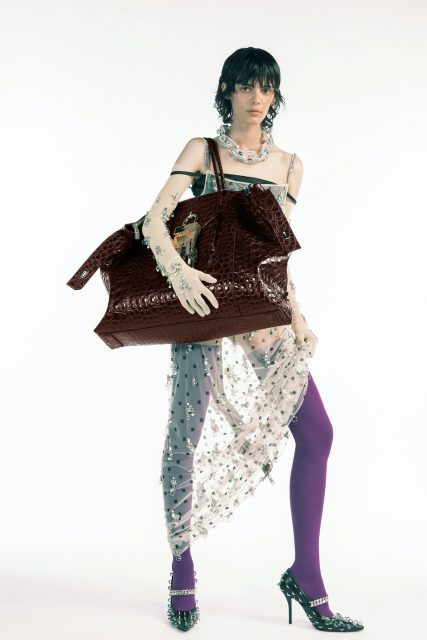“Hope is the last thing to die. That’s the Russian saying.” That’s the smasheroo of a remark that Demna Gvasalia threw into a long debrief about how he got himself into the making of the Balenciaga collection and video, which aired on the Paris Fashion Week schedule today. “You know, I couldn’t wait not to do a show. It didn’t feel right with the way things are. So we’ve made a music video,” he said on the phone from his home in Switzerland. “My husband recorded that ’80s track by Corey Hart, ‘I wear my sunglasses at night’—because you know, is there anything more absurdly fashion than that? It’s also allegorical. You know, where is fashion going? It’s out there, searching in the dark at the moment, not seeing…”
But wait—there is nothing dystopian about this video. Au contraire: Gvasalia’s tribe of Balenciaga nighttime people are each captured as if heading somewhere with a purposeful step. We see them as they walk along the Rue de Rivoli, past the Tuileries gardens, embodying exactly the inimitable cool of the type of people who turn heads after dark on the streets of Paris. We clock them, we check out their clothes, how they’ve put them together, each to their own. They feel real—a visceral, vicarious vision of modern glamour, playing out against the backdrop of a Paris we’d all love to be part of again.
Something happened to Gvasalia during lockdown. The very man who plunged his fashion show audience into a terrifyingly apocalyptic show experience last season has come back with his head in a far more optimistic place. “Because some day we will be out of this.” He imagined a man who leaves the house near the site of Cristóbal’s Maison—a Black guy, setting out in an oversized navy suit, wraparound shades, and what looks to be a sweater draped over his head (but is a ready-made Balenciaga accessory). “So,” Gvasalia related, “he walks through the night, going through lots of changes, morphing into her, him, them. And they end up meeting as friends, going to a party or a club maybe—and everyone is without masks. That’s the hope!” Pandemic-end pending, however, the film credits meticulously set out every detail of the COVID-secure measures taken to safeguard models and crew.
Fashion hope, though? No matter how inspiring clothes might look, what is fashion without its designers taking responsibility for longer-term salvation? The designer who’s always acted as luxury fashion’s foremost prophet of environmental doom said he’d taken his four months of isolation thinking around that very seriously. The impetus of the collection was “imagining how fashion will be in 2030. When thinking of the future, it’s not a Stanley Kubrick space-age vision for me. Mine is very much down to earth. Ten years from now, everything in fashion will be sustainable. No discussion, right? I think we will be reusing the clothes we have. Time makes things beautiful. I heard a quote from Martin Margiela when I was working there, about the value of ‘the trace of time’ in clothes. That touched me deeply. We keep clothes like that to death. I mean, I have a hoodie that’s 15 years old. It’s bleached out and has holes in it. But I cannot throw that away. So, I thought: In the year 2030, how will your favorite things look, aged and destroyed?
A press release specified: “93.5% of the plain materials in this collection are either certified sustainable or upcycled. 100% of the print bases have sustainable certifications.” With the resources of the Kering Group at hand, Gvasalia said, “we discovered we could do it quite easily, with the exception of the fibers that are in some of the existing fabrics. There are solutions if you look for them. There’s a need to revise things. To start a new chapter.”
Some strategies came from a primal psychological reconnection with why clothes matter to him. Others amplify—literally—the relevance of the oversized look (from tailoring to hoodies) that Gvasalia was responsible for launching in fashion in the first place. “It became very obvious to try to do garments that are unisex, uni-size, uni-everything—or whatever we want to call it. It drastically reduced the number of cuts and fits we had to make. Also, I like the fact that according to who wears it, the silhouette changes, but whoever wears it, it looks good.”
That much is very true: Ignoring gendered clothing categories—one vast pair of shared jeans, one huge coat, or a giant shirt at time—feels, well, just noncontroversially (though absolutely desirably) logical by now. His thought process about upcycling—“draping and patchworking things to give them new life”—also tracks back to something he remembered that he really believes in during lockdown. “At first, I was lying there, watching CNN, constantly refreshing the news about hospitalization numbers and going insane,” he said. “Then I started to dress up with all the clothes I have here—cutting up clothes, remaking them, remembering what I did as a kid, trying on personas. Playing with fashion in a way [that] makes you happy.” He laughed, “I mean, I was putting on high heels in my shoe size because I wanted to feel what women feel, wearing platforms at my home desk. This is something I’d never do! It made me remember that I love garments. Clothes.”
Socially observant wit that Gvasalia is, WFH-wear also features in the collection. There are hotel slippers on a heel. Comfortable “orthopedic” sandals, ditto. A red bathrobe coat—which is actually sustainably sourced woolly teddy bear fabric: “Which reminds me, funnily enough,” he concluded, chuckling, “of Cristóbal’s red opera coat.”
Editor
Sarah Mower





